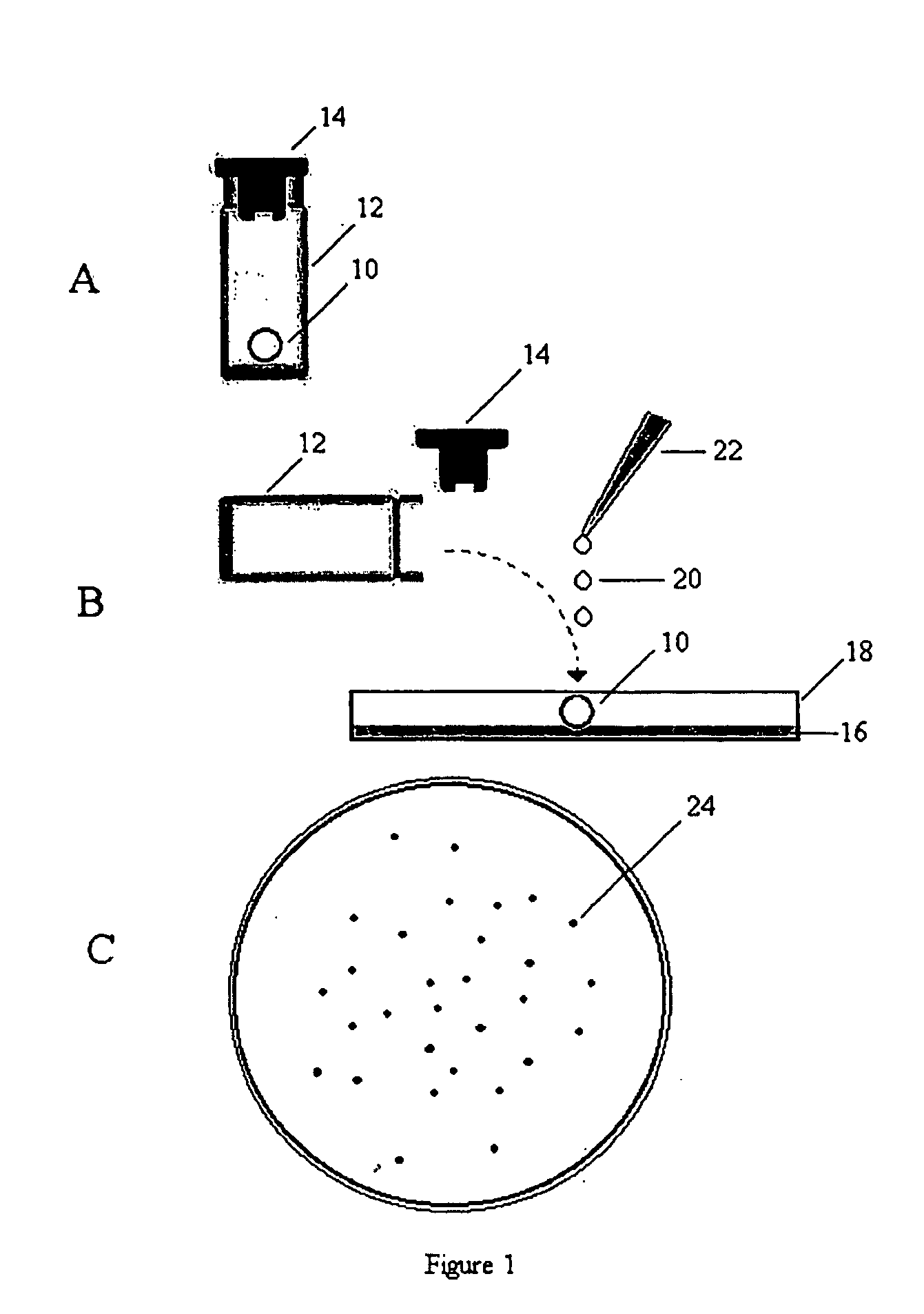Products containing quantum of bioparticles and method for production thereof
a bioparticle and quantum technology, applied in the field of bioparticle products containing quantum, can solve the problems of inability to know exactly, inability to accurately provide the number of bioparticles, and inability to accurately disperse the amount of bioparticles, etc., to achieve accurate dispensing and accurate dispensing of bioparticles
- Summary
- Abstract
- Description
- Claims
- Application Information
AI Technical Summary
Benefits of technology
Problems solved by technology
Method used
Image
Examples
example 1
Production of Products Using a Electrostatic Cell Sorter
Preparation of E. Coli
A strain of E. coli (NCTC 9001) was grown at 37° C. for 24 hours in 1.6% (w / v) tryptone and 1% (w / v) yeast extract at pH 7.2. The cells were diluted 1 in 1000 in filtered (0.22 μm) phosphate buffered saline (PBS) (Sigma Chemical Company, Sydney, NSW) and analysed immediately.
Analysis of E. Coli
The sample of E. coli was analysed using a Becton Dickinson FACStarplus flow cytometer fitted with a 488 nm water cooled argon ion laser. A 100 μm nozzle was fitted and the cytometer set up for sorting according to the manufacturers instructions. Sheath fluid consisted of filtered (0.22 μm) PBS plus 4% (w / v) bovine serum albumin fraction V (Sigma Chemical Company at pH 7.4.
A region was defined on a scatter plot of Side scatter verses Forward scatter that contained the E. coli. This region was then used to sort the E. coli.
Selection of Desired E. Coli
The cytometer was set, according to the manufacturers ...
example 2
Production of Products that Contain a Quantum of Viable E. Coli Cells
Preparation of E. Coli
A strain of E. coli (NCTC 9001) was grown at 37° C. for 24 hours in 1.6% (w / v) tryptone and 1% (w / v) yeast extract at pH 7.2. The cells were diluted 1 in 1000 in filtered (0.22 μm) PBS and analysed immediately.
Analysis of E. Coli
The sample of E. coli was analysed using a Becton Dickinson FACScalibur flow cytometer that had been modified to enable 30 cells to be dispensed within a single droplet. Serum was injected into the droplet whilst it was forming to enable production of a droplet that freeze dries into a spherical mass without modifying the flow cytometer's sheath fluid.
The cytometer modification involved inserting, into the capture tube within the flow cell, a length of hypodermic tubing (A-M Systems, Calsborg, USA). A length of silicon tubing was connected to the hypodermic needle (A-M System, Calsborg, USA). A length of hypodermic tubing was connected to other end of the sil...
example 3
Production of Balls that Contained a Quantum of Bacillus Subtilis Cells Containing a Single Copy of a Green Fluorescent Protein (GFP) Gene
The ability to provide a sample which contains a defined number of genes will be particularly useful in molecular biological assays. In this situation, the bioparticle can be a microorganism which harbours a known number of copies of a particular gene. The gene maybe in one or more vectors in the microorganism, or incorporated in the genome of the microorganism.
Preparation of Bacillus Subtilis
A strain of Bacillus subtilis (1049 Pxyl rpsB-GFP) was grown in nutrient broth plus 1% (w / v) xylose at 37° C. for 12 hours. This strain contained a single copy of the green fluorescent protein gene (GFP) under the control of a xylose promoter. The sample was diluted 1 in 1000 into filtered (0.22 μm) PBS plus 1% (w / v) xylose.
Analysis of Bacillus Subtilis
The sample of Bacillus subtilis was analysed using a modified Becton Dickinson FACScalibur flow cy...
PUM
| Property | Measurement | Unit |
|---|---|---|
| volume | aaaaa | aaaaa |
| volume | aaaaa | aaaaa |
| diameter | aaaaa | aaaaa |
Abstract
Description
Claims
Application Information
 Login to View More
Login to View More - R&D
- Intellectual Property
- Life Sciences
- Materials
- Tech Scout
- Unparalleled Data Quality
- Higher Quality Content
- 60% Fewer Hallucinations
Browse by: Latest US Patents, China's latest patents, Technical Efficacy Thesaurus, Application Domain, Technology Topic, Popular Technical Reports.
© 2025 PatSnap. All rights reserved.Legal|Privacy policy|Modern Slavery Act Transparency Statement|Sitemap|About US| Contact US: help@patsnap.com

